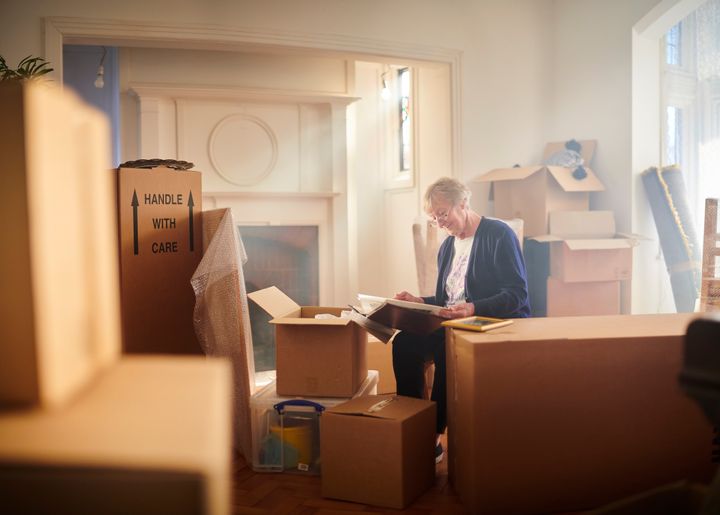More women than men move out after widowhood

More than 280,000 people in Denmark over the age of 50 are widows or widowers. Losing one’s life partner causes upheaval in a variety of ways. One of these many parameters can have to do with moving out. However, the residential mobility of Danish women and men after the loss of a partner can diverge significantly. This is the finding of a University of Copenhagen study.
"There is a clear gender gap between widows and widowers when it comes to housing and where one settles – especially in relation to how much one moves. Widows and widowers seem to be affected differently by their new living situation," says Aske Egsgaard-Pedersen, a geographer and former PhD student at UCPH’s Department of Geosciences and Natural Resource Management.
Using registry data, he studied the patterns of residential changes for tens of thousands of Danish widows and widowers between the ages of 50 and 90 over a 25-year period.
Women are much more mobile
The study demonstrates that widows move far more than widowers following the passing of a partner. While just over 30% of all widows move into new homes after the death of their partner, this is true for only 20% of widowers. At the same time, a slightly larger proportion of women than men move into residential care.
Furthermore, widows are statistically more likely to move than other women for up to four years after the death of their partner, compared to only two years for widowers. Likewise, widows are also more likely to move than widowers in the years immediately following the death of their partner.
"We were unable to determine the underlying causes of the differences we observed. But a significant amount of previous research indicates that widows are generally worse off financially than widowers because men typically have a higher income and larger retirement savings. So, one reason may be that widows experience a greater – and longer lasting – deterioration of their financial situations than widowers, which makes it necessary for them to move into something cheaper," says Aske Egsgaard-Pedersen.
He adds:
"But at the same time, several studies indicate that women often have stronger social networks than men and thereby experience more emotional support in the situation. This may make them less 'afraid' than men of moving into a residential situation that, in reality, might be more appropriate. So, this could be part of the explanation for the gender difference in the statistics."
Fewer square meters
The study also demonstrates that both women and men downsize after transitioning into widowhood. Where widowers reduce the size of their residences by 9 m2 on average, widows reduce their living space by 12 m2.
"It isn’t surprising that both sexes move into smaller residences. But, here too, there is a statistical gender difference in how much smaller their home becomes. Again, it is natural to point to personal finances as a possible cause," says the researcher.
Better housing alternatives for the elderly
Aske Egsgaard-Pedersen points out that there is a need for qualitative research into the underlying causes.
"Even in a Nordic country where gender equality is a big deal, there remains a way to go before there are equal opportunities for men and women when they lose their life partners. Here, we should take a closer look at what can be done to support both men and women during a difficult phase of their lives and be attuned to the fact that widows and widowers are not all the same, with the same behaviours or needs," says Aske Egsgaard-Pedersen.
Geographer and associate professor Høgni Kalsø Hansen of the Department of Geosciences and Natural Resources Management agrees.
He believes that more knowledge about what causes widows and widowers to move, and what prevents them from doing so, can benefit both individuals and society:
"The figures from this study also show that the majority of both widows and widowers remain in their homes – this applies to 70% of women and 80% of men. And, of course, that's fine if that's what they want. But if many of them – perhaps men in particular – actually stay put because they are experiencing social challenges, something should be done to create attractive alternatives for them," says Høgni Kalsø Hansen, who continues:
"This issue might be considered with regards to housing and urban planning by, for example, planning more smaller-sized homes that are both economically and socially attractive – and where an active life and networks are available for them to take part in. At the same time, this would release housing stock into the market. Instead of constantly building new buildings, we could make better use of the existing housing."
The results from the study have been published in the scientific journal Housing Studies.
Keywords
Contacts
Aske Egsgaard-Pedersen
aske7co@gmail.com
+45 25 63 20 42:
Maria Hornbek
Journalist
Faculty of Science
University of Copenhagen
maho@science.ku.dk
+45 22 95 42 83
Images

Links
About Københavns Universitet - Det Natur- og Biovidenskabelige Fakultet
 Københavns Universitet - Det Natur- og Biovidenskabelige Fakultet
Københavns Universitet - Det Natur- og Biovidenskabelige FakultetBülowsvej 17
1870 Frederiksberg C
35 33 28 28https://science.ku.dk/
Det Natur- og Biovidenskabelige Fakultet på Københavns Universitet – SCIENCE – er landets største naturvidenskabelige forsknings- og uddannelsesinstitution.
Fakultetets væsentligste opgave er at bidrage til løsning af de store udfordringer, som vi står overfor i en verden under hastig forandring med øget pres på bl.a. naturressourcer og markante klimaforandringer - både nationalt og globalt.
Subscribe to releases from Københavns Universitet - Det Natur- og Biovidenskabelige Fakultet
Subscribe to all the latest releases from Københavns Universitet - Det Natur- og Biovidenskabelige Fakultet by registering your e-mail address below. You can unsubscribe at any time.
Latest releases from Københavns Universitet - Det Natur- og Biovidenskabelige Fakultet
Internet can achieve quantum speed with light saved as sound15.4.2024 11:16:35 CEST | Press release
Researchers at the University of Copenhagen’s Niels Bohr Institute have developed a new way to create quantum memory: A small drum can store data sent with light in its sonic vibrations, and then forward the data with new light sources when needed again. The results demonstrate that mechanical memory for quantum data could be the strategy that paves the way for an ultra-secure internet with incredible speeds.
Internettet kan få kvantefart med lys gemt som lyd15.4.2024 10:47:07 CEST | Pressemeddelelse
Forskere ved Niels Bohr Institutet på Københavns Universitet har udviklet en ny måde at skabe såkaldt kvantehukommelse: En lille tromme kan gemme data sendt med lys i dens lydvibrationer, for siden at sende data videre med nye lyskilder, når det igen skal bruges. Resultaterne understreger at en mekanisk hukommelse for kvantedata kan være strategien, der baner vej for et ultra sikkert internet med utrolige hastigheder
Hegn og veje har givet ikonisk savannedyr genetiske problemer12.4.2024 11:06:30 CEST | Pressemeddelelse
De ikoniske gnu-vandringer er blevet et særsyn i Afrika, fordi vi mennesker har afskåret dyrenes historiske vandringsruter med veje, hegn, byer og landbrug. Og det har ført til genetisk forfald i de bestande, som ikke længere har mulighed for at flytte sig, viser ny forskning, som Københavns Universitet har stået i spidsen for.
Iconic savanna mammals face genetic problems due to fences and roads12.4.2024 11:04:29 CEST | Press release
Wildebeest migrations have become a rarer sight in Africa as humans continue to interrupt their historic migratory routes with roads, fences, cities, livestock and farmland. This has led to genetic decay in those herds that are no longer able to roam freely, according to new research led by the University of Copenhagen.
Economist: Tens of billions of dollars in forest products are being overlooked11.4.2024 11:17:39 CEST | Press release
Are we missing the forest for the trees? More than timber grows in forests – including products worth many tens of billions of dollars. Because these goods go unrecorded in official trade statistics, their economic value escapes our attention. As a result, clear opportunities to combat poverty are being missed, according to a University of Copenhagen economist.
In our pressroom you can read all our latest releases, find our press contacts, images, documents and other relevant information about us.
Visit our pressroom